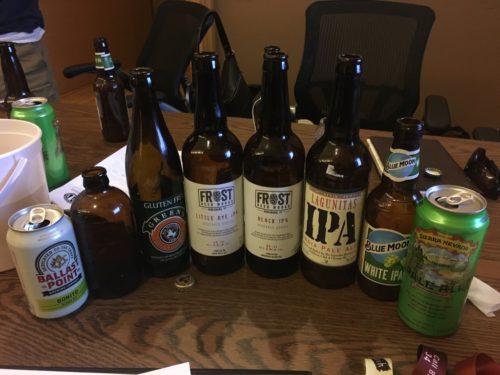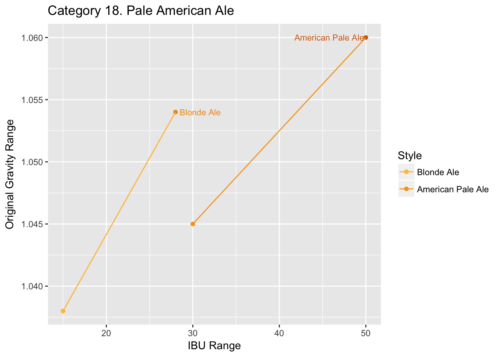BJCP Study Group: Categories 18 & 21
¶ by Rob FrieselSession #6 of our BJCP study group combined two categories that almost everyone who drinks craft beer in the United States should be pretty familiar with. With the exception of a couple of odd ball sub-styles (looking at you, Red IPA), we somehow managed to do a tasting run of nearly every flavor the two categories had to offer.
The night was going to have a very full agenda. Despite “only” four styles to cover, Specialty IPA (21B) has six sub-styles in the 2015 BJCP style guide, to say nothing of proposed sub-styles like New England IPA, creative interpretations, or “alternative grain” versions. We managed to get most of them (some commercial and some homebrew) but we didn’t manage to organize a training exercise (aside from the usual structured evaluations), nor did we have a guest judge.
Categories 18 (Pale American Ale) & 21 (IPA)
Categories 18 and 21 represent what is probably the majority of modern American craft beers. These are the beers that are generally 1 light in color, have clean fermentation characteristics, and range from moderately bitter to strongly bitter. Beers in both of these categories tend to be hop-forward, with some acceptable regional variations, and (especially in the case of 21B) room for creative interpretations. As with most styles, balance is an important factor in the overall impression for these beers, and even the more aggressive, hop-forward examples must not be harsh.
| 12A. Blonde Ale | 12B. American Pale Ale |
|---|---|
| 15 – 28 IBU | 30 – 50 IBU |
| 1.038 – 1.054 O.G. | 1.045 – 1.060 O.G. |
| 1.008 – 1.013 F.G. | 1.010 – 1.015 F.G. |
| 3.8 – 5.5% ABV | 4.5 – 6.2% ABV |
| 21A. American IPA | ||
|---|---|---|
| 40 – 70 IBU | ||
| 1.056 – 1.070 O.G. | ||
| 1.008 – 1.014 F.G. | ||
| 5.5 – 7.0% ABV | ||
| 21B1. Belgian IPA | 21B2. Black IPA | 21B3. Brown IPA |
| 50 – 100 IBU | 50 – 90 IBU | 70 – 70 IBU |
| 1.058 – 1.080 O.G. | 1.050 – 1.085 O.G. | 1.056 – 1.070 O.G. |
| 1.008 – 1.016 F.G. | 1.010 – 1.018 F.G. | 1.008 – 1.016 F.G. |
| 6.2 – 9.5% ABV | 5.5 – 9.0% ABV | 5.5 – 7.5% ABV |
| 21B4. Red IPA | 21B5. Rye IPA | 21B6. White IPA |
| 40 – 70 IBU | 50 – 75 IBU | 40 – 70 IBU |
| 1.056 – 1.070 O.G. | 1.056 – 1.075 O.G. | 1.056 – 1.065 O.G. |
| 1.008 – 1.016 F.G. | 1.008 – 1.014 F.G. | 1.010 – 1.016 F.G. |
| 5.5 – 7.5% ABV | 5.5 – 8.0% ABV | 5.5 – 7.0% ABV |
And as a coincidental aside: we were doing the IPA category on IPA Day.
- 18A. Blonde Ale. Ballast Point Bonito. Structured tasting. There was a bit of spread in the scores, but we were mostly in the mid-30s. (I was on the low side at 30.) We discussed “bready” aromas, focusing on how we tried to differentiate malt-derived “bready” aromas (appropriate) from yeast-derived ones (inappropriate). 2 We also discussed how to differentiate between out-of-balance bitterness from astringency. We concluded that what some perceived as astringency in this beer was more likely a high level of bitterness. What was particularly interesting about this observation was that while some of us (myself included) would have been happy to conclude that the example was too bitter for the style, one member of our group pointed to the “History” section of the style guide, indicating the statement that West Coast blonde ales could (due to regional variation) take on a more aggressive character. And, well, Ballast Point is brewed in San Diego.
- 18B. American Pale Ale. Sierra Nevada Pale Ale. Structured tasting. We had a bimodal distribution of scores, with about half of us in the 30s and half in the 40s. Ultimately this round of evaluation reinforced the need to do the tastings blind. The half the judged with low scores had peeked at the “canned on” date, noting it was 3 months old; the higher-scoring half didn’t look, but couldn’t help shake that Sierra Nevada is often held up the classic example of the style. On the subject of the beer’s age, we talked through how the age doesn’t necessarily “spoil” the flavors, but it can certainly dial down the intensity.
- 21A. American IPA. Lagunitas IPA. Structured tasting. “West Coast!” someone blurted out. We generally scored it well (mostly low-40s) and got into a discussion about how to know when the bitterness is “too harsh”. We didn’t come to any specific conclusions, but called back to the judging advice we received two weeks ago: “…trust yourself and your perceptions.”
- 21B. Belgian IPA. Green’s Gluten-Free IPA. Unstructured tasting. “I guessed it was a Belgian IPA because the label said it’s made in Belgium.” This was an interesting beer to evaluate. It did not read like a Belgian IPA to any of us — none of the typical yeast-derived character. It was also darker than we would expect it to be. A couple of us commented on an unpleasant “solventy” aroma and flavor; the most likely explanation was a “too hot” fermentation. There were other hard-to-pin down aromas and flavors, and we conjectured that these were from the gluten-free malts. We had a brief sidebar discussion about Alternative Grain Beers (31A) and the challenges of scoring those if you’re unfamiliar with (say…) malted millet.
- 21B. Black IPA. Frost Black IPA. Unstructured tasting. The aromas bordered on unpleasant, and in part because they were unexpected. A lot of dark grain character (chocolate, medium roast coffee, and roasted-but-almost-burned malts) but practically no hop-derived aromatics. Based on aroma alone, I almost couldn’t drink it. But the flavors were better than that, though as one group member observed: “It works to think of it as a highly-hopped porter.”
- 21B. Brown IPA. Dan’s homebrewed Brown IPA. Unstructured tasting. Decidedly the right color, and decidedly hazy, but also decidedly astringent. Dan described the process for making it, that it was a “sparge beer” (parti gyle), which is likely what explained the grainy character and astringency. We also learned that the batch size was quite small (1 gallon) and was likely over-hopped.
- 21B. Rye IPA. Frost Little Rye IPA. Unstructured tasting. Generally well-received by members of the group, with “guesstimate” scores in the high-30s and low-40s. It had a good, strong rye character that married well with its aroma hops. That said, my own notebook scribbling said: “lacks depth”.
- 21B. White IPA. Blue Moon White IPA. Unstructured tasting. Nearly instant dumper for most members of the group. Overwhelming cooked cabbage character that we attributed most likely to DMS. (Which seemed strange that there would be such an obvious fault in a commercial beer… but there you have it.) As one group member observed: “It’s like a highly hopped witbier, which I guess is what this style boils down to — except that this is like they’re just throwing a ton of hops to cover up a poorly executed wit.”
- 21A. American IPA. The Alchemist’s Skadoosh #9. At this point, not even an unstructured tasting — just passing around the can to get a taste.
- Bonus beers. We finished out the night with a couple more tastings of homebrews: a “Milkshake” IPA, an IPA with someone’s home-grown hops (Cascade and Centennial), a Lacto.-soured pale ale with apricots, and a Flanders red.
Takeaways
The themes and broad observations from the night:
- Scoring technique. Revisiting this theme from last time. A few of us had made an effort to follow Tyler’s advice and start from the total score, allocating across the characteristics later. Personally, I find this approach very challenging. I’ll likely try it a few more times, but I don’t know that I can make it stick. 3
- Impact of freshness. We generally agreed that the primary effect of age in an otherwise well-packaged beer was a reduction in intensity, and not necessarily oxidation. (Interestingly, no one brought up oxidation even once during the evening, and normally this is a fault that is brought up several times.)
- Pay attention to regional variations. I was really grateful to the group member that called attention to the History section so early in the evening. It’s almost too easy to narrow your focus to just what’s in the main part of the style guide. Looking at the Comments, History, and Style Comparison sections can give important insights into the appropriateness of a beer’s variation from the mainline.
- Variation in perceptions. Each of us at the table are different, and have different perceptions happening in our brains. We noted that this seemed to take two forms. The first was a question of sensitivity: are you “blind” to certain characteristics? or hyper-sensitive to them? We had several times throughout the evening where one person or some subset of the group would “get” an aroma or flavor that others simply did not. The second form we saw it take was with different attributions. Again, with the Bonito, almost everyone perceived the “bready” character, but different people attributed it to different things — malt (appropriate) vs. yeast (inappropriate).
- Remember to comment on attenuation! Sometimes saying that something “finishes dry” isn’t enough. Be more specific. Call out whether or not you believe the yeast to have “finished the job” and fully attenuated the beer. (Or, as we may see with future styles, whether it was too attenuated.)
- I say “generally” because the Specialty IPA (21B) sub-styles, despite all having pretty similar and characteristically hop-forward aroma and flavor profiles, run the gamut of colors.[↩]
- We concluded these were likely yeast-derived because they smelled like a starter.[↩]
- A side note on this point: part of the reason that I found this approach so challenging and frustrating is that I believe if it was ever going to be “easy” to use that approach, it was going to be on the Category 18 and 21 beers, which I’m quite familiar with. It just felt strange to me to think “this is a 26” and then distribute the points, find that I had only 10 “leftover” for Flavor and think “but how can I justify that?”[↩]
About Rob Friesel
Software engineer by day. Science fiction writer by night. Weekend homebrewer, beer educator at Black Flannel, and Certified Cicerone. Author of The PhantomJS Cookbook and a short story in Please Do Not Remove. View all posts by Rob Friesel →4 Responses to BJCP Study Group: Categories 18 & 21
Pingback: BJCP Study Group: Category 19 (and/or Russian Imperial Stouts) | found drama



Leave a Reply